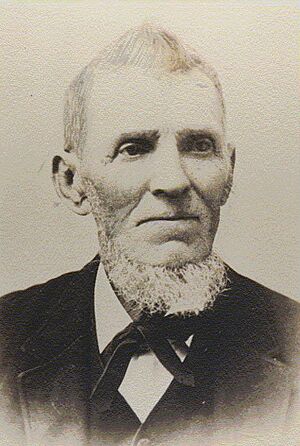Gijsbert Haan facts for kids
Gijsbert Haan (born January 3, 1801 – died July 27, 1874) was an important leader for Dutch-Americans in the United States and Canada. He led a big split from the Reformed Church in America in 1857. This split led to the creation of a new church called the Christian Reformed Church.
Contents
Early Life and Moving to America
Gijsbert Haan was born in Hilversum, North Holland, Netherlands, on January 3, 1801. He grew up as part of the Reformed Church there. He married Marritje Pos, and they had at least 13 children. Ten of their children lived to be adults.
On July 26, 1847, Gijsbert and his family moved from the Netherlands. They sailed on a ship called the Centurion. They left their home because of tough social and religious times, and there was also a serious lack of food.
They settled in Holland, Michigan, guided by Albertus van Raalte. By 1850, their group of churches joined the Reformed Church in America (RCA). This meant they became a "classis," which is like a local governing group for several churches in the Reformed system. It included church leaders and elders.
Wanting a Different Church
Most churches in their group were happy with the RCA. But Gijsbert Haan's church felt the RCA was not strict enough. Haan believed the RCA "was not sound," meaning it wasn't following the rules as closely as he thought it should.
This feeling was similar to a past split in the Netherlands. There, the Reformed Churches in the Netherlands had separated from the Dutch Reformed Church. This happened because some people felt the Dutch Reformed Church was becoming too relaxed in its beliefs. Over time, more people started to disagree with the RCA, largely because of Haan's strong preaching.
The Big Split of 1857
In 1857, Gijsbert Haan's followers sent official papers to their classis. They wanted to leave the RCA and hoped others would join them. Their main reasons for wanting to leave were:
- The RCA allowed "open communion," meaning people who weren't full members could take part in a special church service.
- The RCA sang hymns (church songs) that were not based directly on Bible psalms.
- The RCA did not focus enough on catechism preaching. Catechism is a way of teaching Christian beliefs through questions and answers.
- The RCA did not support the earlier church split that happened in the Netherlands.
The classis did not agree with their reasons for leaving. However, one church decided to leave the RCA in January 1857. Soon, other churches followed their lead.
In 1859, these churches that had left the RCA formed a new group called the True Dutch Reformed Church. This church changed its name several times over the years. In 1904, it became known by its current name, the Christian Reformed Church (CRC).
Growth of the Christian Reformed Church
The CRC started as a church for Dutch immigrants in the 1850s. It continued to attract mostly Dutch people. The number of people in the church grew a lot when many Dutch immigrants came to America.
For example, the church in Canada gained many new members after World War II. This was when a large number of people from the Netherlands moved there. The CRC also welcomed people who were unhappy with the RCA for different reasons and decided to leave.
Gijsbert Haan continued to preach in the new CRC until he passed away in 1874. Some of his children, grandchildren, and great-grandchildren also became leaders in the CRC.
In the early years, most of the church services were held in the Dutch language. This was because most of the church members were immigrants. By the early 1900s, CRC churches could be found in many US states. Services were held in both Dutch and English. Gijsbert Haan died in 1874 in Grand Rapids, Michigan, from liver disease.


